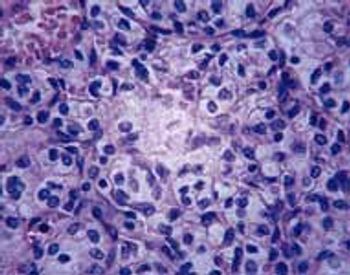
A treatment tip for dogs.

A treatment tip for dogs.

The MAF is beginning a long-term study to identify the risk factors for the development of cancer and other diseases in dogs.

Orlando -- The Morris Animal Foundation will launch a 13-year longitudinal veterinary study this year to examine cancer in Golden Retrievers.

Important diagnostic and staging pointers.

Short Hills, N.J. -- The Food and Drug Administration (FDA) granted conditional approval to AB Science for a new treatment for canine mast cell tumors.

A novel form of pain relief for canine osteosarcoma.

Investigators from the University of Tennessee's College of Veterinary Medicine recently published their findings evaluating tumor response and overall survival rate and time for dogs with nonresectable MCTs treated with masitinib.

Veterinary oncologist Dr. Kim Selting provides her advice on achieving the best outcomes in these cases.

Columbia, Mo. -- Researchers at the University of Missouri (MU) College of Veterinary Medicine have started a clinical trial on a human oncology drug which may prove useful in the battle against canine cancer. The drug Attaxol?, which is made by CritiTech in Lawrence, Kan., could be ideal for use in dogs with naturally occurring cancer, says Dr. Kim Seltin, assistant professor of oncology at the MU College of Veterinary Medicine.

Some recommendations regarding vaccination and reducing the risk of vaccine site-associated sarcoma.

Wentzville, Mo. - A new cancer care center, operated by the University of Missouri College of Veterinary Medicine, will open this spring and offer pet owners more options for specialty care.

Do we all interpret cytology findings the same way?

The key to this alternative form of cancer therapy.

Fort Collins, Colo. -- Colorado State University?s Animal Cancer Center has created a new chair in comparative oncology, thanks to a $3 million gift from the Shipley Foundation.

Advice for formulating your surgical plan.

Mast cell tumors are the most commonly encountered malignant skin tumor in the dog. They account for 16-21% of all cutaneous tumors and boxers, Boston terriers, Labrador retrievers, beagles and schnauzers are documented to be at increased risk. Alterations in the c-kit receptor (receptor for growth factor SCF) are noted in many high grade tumors. Histologic grade is highly predictive of behavior.

Biopsy and histopathology remains the gold standard diagnostic test for many conditions and for nearly all tumors and cancers. When performing this test, it is important to know what answers to look for, in order to obtain as much critical information as possible that may eventually impact the prognosis and the treatment planning.

It can be estimated that more than half of tumor-bearing pets suffer cancer-related pain. Quality of life and key physiological functions are negatively impacted by pain, and treating it is a priority. Whether cancer pain is confirmed, suspected, or expected to occur, efforts should be spent to treat it effectively.

Head and neck tumors are relatively common in aging cats. Understanding the differential diagnoses in this anatomic area is crucial as the diagnostic and therapeutic approaches may vary. This lecture will discuss feline oral tumors, sinonasal tumors, iris melanoma, Hodgkin's-like lymphoma, salivary gland tumors, tumors of the ear canal, and skin tumors.

This is the most common reason for presentation to the emergency clinic in patients currently undergoing chemotherapy. Any chemotherapy patient that is not feeling well should have a CBC performed, as well as a thorough physical examination.

Canine lymphoma comprises approximately 7-24% of all canine neoplasia and 83% of canine hematopoietic malignancies. This translates to ~24/100,000 dogs at risk and is one of the most commonly treated malignancies both in the private practice and specialty setting.

The biggest problem to overcome before treating pain in veterinary medicine is properly identifying the pain. Our patients cannot tell us what they're feeling using intelligible words, or by describing their symptoms. We therefore need other means to determine that the patient is experiencing pain, and to plan an appropriate treatment.

Canine lymphoma has long been regarded and addressed as a single disease entity, while human lymphomas are classified in numerous classes and subclasses, each with a distinct presentation, prognosis, and accepted therapy.Indolent, or low-grade, lymphomas constitute a unique subgroup of lymphomas that often may behave differently than the archetypical high-grade canine multicentric lymphomas.

Hemangiosarcoma (HSA) is a highly malignant cancer originating from vascular endothelial cells. More frequent in dogs than in any other domestic species, with a reported prevalence of 2 % of all canine tumors, it is associated with a high fatality rate. Hemangiosarcoma typically affects older dogs, averaging 10 years of age at diagnosis, and a strong sex overrepresentation has not been identified.

Oral tumors account for ~6% of canine tumors making them the fourth most common neoplasm in that species. Four major histologic classifications; fibrosarcoma, melanosarcoma, squamous cell carcinoma and the epulides account for the vast majority of cases. Other less common diagnoses include lingual tumors, tonsillar SCC, viral papillomatosis, eosinophilic granuloma complex and papillary squamous cell carcinoma of young dogs.